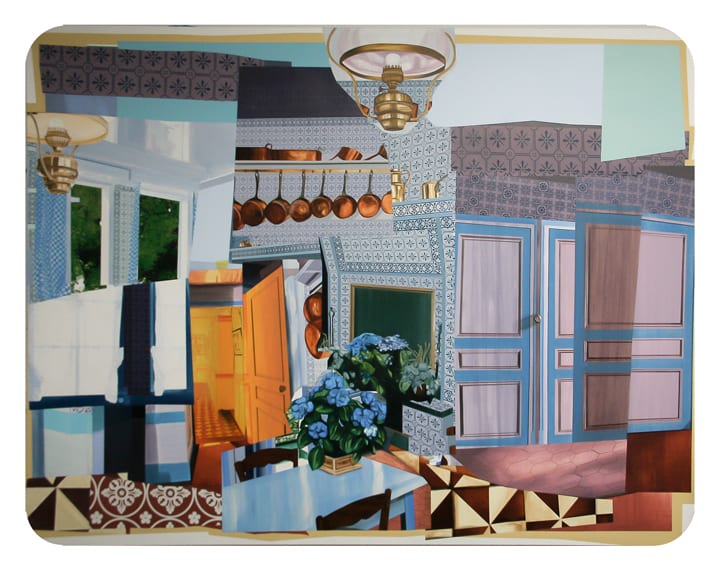Pippy Houldsworth Gallery is delighted to present Domestic Unrest with Rosson Crow, Francesca DiMattio and Mickalene Thomas from 13 March to 26 April 2014. Bringing together three of the most innovative American artists working today, the exhibition explores how each of these female artists subverts conventional depictions of domesticity by challenging the modes through which such spaces are traditionally represented.
Exploring the significance of the domestic realm in relation to issues of race and gender, Mickalene Thomas’ work questions what it means to be a black woman in today’s society. Often populating her work with self-assured, black protagonists, Thomas’ brightly-coloured interiors challenge orthodox notions of domesticity by drawing upon, and subverting, traditional representations of the home.
Mickalene Thomas’ visual aesthetic is heavily inspired by the modernist décor illustrated in The Practical Encyclopedia of Good Decorating and Home Improvement. Published in 1970, the eighteen-volume anthology contains detailed reproductions of stylish domestic interiors from the era in which the artist grew up, directly influencing the furnishings, colour schemes and patterned fabrics which feature in her work. Coupled with photographs taken by the artist, Thomas integrates scans of designs and textiles from the anthology within her collages. Characterised by blocks of vibrant colour and shifting planes of perspective, Thomas often uses these smaller works as preliminary studies for her paintings.
Drawing upon her residency at Claude Monet’s home in Giverny in 2011, Thomas has produced a new, large-scale painting, Monet’s Kitchen, for the show. Collapsing foreground and background, the artist has re-contextualised the architecture from Monet’s kitchen to form a fragmented perspective of his home. Adorned with rhinestones, Thomas’ mode of re-assemblage serves to revitalise the space.
Francesca DiMattio disrupts conventional depictions of interior space by constructing complex, multi-layered scenes. Ladders, ropes, table legs, flowers and fabrics converge in haphazard conglomerations, creating problematic, but strangely familiar, depictions of domestic interiors. Interested in the space between things, DiMattio looks at the shapes created when three-dimensional objects intersect on a two-dimensional plane.
Within her paintings, the artist destabilises the interrelation between physical and virtual reality by fabricating surreal, architectural realms that extend beyond the confines of the canvas, hanging her work alongside distorted, ceramic sculptures that appear to have been plucked directly from her paintings. Discussing her work for the show, DiMattio explains: ‘I wanted to handle the floral and the decorative in an aggressive way. Taking ornamental motifs found in the home, I wanted to present them alternatively. Moving through the painting and sculpture like a virus, these modes of embellishment become inherently grotesque in their excess.’
Creating hallucinatory visions of desolate, interior spaces, Rosson Crow transports the viewer to unnerving environments charged with psychological and historical significance. For Domestic Unrest, Crow revisits the exuberant and colourful interiors for which she has become famous over the past ten years. This new body of work manifests Crow’s interest in the significance of gendered spaces and how the psychology of these environments can be disrupted. In particular, she is concerned with subverting traditional representations of domesticity by inserting, and re-contextualising, sexist iconography within her paintings.
For example, Party Girl Disrupts Table Setting is a satirical portrayal of a woman diving head first into an elegantly set dining table. Adorned with black stilettos, the splayed legs jutting out of the centre of the painting are inspired by the erotic, sado-masochistic furniture of Allen Jones and Crow’s ‘love/hate relationship’ with his work. Here, Crow re-appropriates a sexualised image of the female body in order to destabilise the formality of the domestic scene. This subversion continues in Black Pussy in the Mirror Room, in which lurid graffiti adorns the inside walls of the Jason Rhoades inspired interior.

